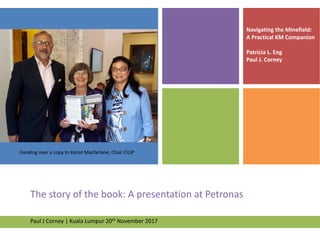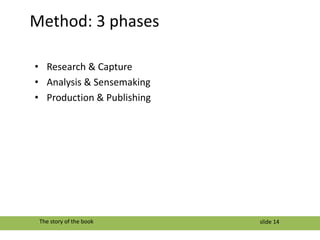The Story of the book: A presentation at Petronas HQ KL
- 2. slide 2 Agenda 1. Genesis 2. Approach 3. Getting going 4. Keeping it going 5. Highlights 6. And finally The story of the book
- 5. Timeline: ŌĆ£Navigating the MinefieldŌĆ”ŌĆØ slide 5The story of the book Ideation Production Publication 2014 2015/6 2017
- 6. Context slide 6The story of the book Patricia Paul Engineer Banker Distinguished US Govt. career Business Leader Regulator in Nuclear Industry Managing Partner in Consultancy Seconded to Nasa Pro bono, teaching & consulting KM career short but successful Long KM career helping global orgs. ŌĆ£I have changed jobs about every 2-3 yearsŌĆØ ŌĆ£You need new challenges even if in the same organizationŌĆØ https://www.engineergirl.org/2958.aspx https://www.linkedin.com/in/pauljcorney/
- 11. Interviewee selection slide 11The story of the book ŌĆó Criteria: ŌĆō A KM professional that actually built a KM program for an organization they worked in, as opposed to a consultant who was brought in to work on a KM program and then left. ŌĆō Have spent at least 2 years on the programme. ŌĆō Primary person responsible for the KM programme ŌĆō interfaces with executives ŌĆō Can point to a clear ROI, e.g., productivity or monetary ŌĆō A KM professional who can speak to what constituted the ROI ŌĆó Based on PaulŌĆÖs global network ŌĆó Based on recommendations from: ŌĆō Patrick Lambe / Shawn Callahan / David Gurteen / Dr. Karuna Ramanathan / Nancy White / Lucy Lameroux / David Piga
- 12. Interviewee list slide 12The story of the book Airbus, Antwerp Port Authority, ARUP, BP, Cadbury Schweppes, Defense Acquisition University, Hewlett Packard (HP), the International Center for Tropical Agriculture, (CIAT), Intellectual Property Office Singapore, Lloyds Register Marine, NASA, MPM PETRONAS, Ontario Workplace & Safety Board, U.K. National Health Service Digital, Sellafield, Shell Oil, and the U.S. Army and Nuclear Regulatory Agency Nb. others were interviewed but chose to retain anonymity
- 14. Method: 3 phases slide 14The story of the book ŌĆó Research & Capture ŌĆó Analysis & Sensemaking ŌĆó Production & Publishing
- 15. Method: research & capture slide 15The story of the book ŌĆó That Patricia would conduct the interviews face to face or via Skype/WebEx/GoToMeeting etc; ŌĆó That interviewees would receive the questions in advance; ŌĆó The interviews would be recorded and stored in Dropbox; ŌĆó That we would both listen to the interviews and transcribe them; ŌĆó That we would send a copy of the interview to the interviewee; ŌĆó That the interviewee would be asked to sign a release form permitting us to use the material.
- 16. Method: analysis & sensemaking slide 16The story of the book ŌĆó We assembled more than 40 hours of interviews. Each needed transcribing and we felt it vital for the subsequent analysis or sense making phase that we each undertook the task. ŌĆó Our transcription styles and ŌĆ£noticingŌĆÖsŌĆØ (what we heard) were different. And we needed to be clear at to the intended audience for the book. We knew we wanted to write something practical not theoretical. ŌĆó So we allocated two days in January 2016 to review all the interviews and begin the process of creating a framework of chapters for the book. ŌĆó We highlighted quotes we felt illuminated points and we pulled out the stories we felt would bring each chapter to life. ŌĆó PatriciaŌĆÖs wall and floor was covered in flip charts and sticky notes.
- 17. Method: production & publishing slide 17The story of the book ŌĆó The choice of Publisher was made mid point and influenced discussions on style, framework and content. But we still had to write the chapters, get agreement on the quotes and attributions and find images that might bring the prose to light. ŌĆó We needed a collaborative platform for the content we would be generating and record the conversations we would be having over the coming months. Despite a few glitches in the way content is stored we settled on Evernote and show below how we worked collaboratively on chapters
- 20. Review panel slide 20The story of the book ŌĆó Criteria: ŌĆō Cover different continents ŌĆō From different disciplines ŌĆó Panel: ŌĆō Eric Hunter, Director of Knowledge, Technology & Innovation Strategies, Bradford & Barthel, LLP and Executive Director, Spherical Models, LLC ŌĆō Larry Campbell, Partner & Head of Financial Services Strategy, KPMG, Former Group Chief Knowledge Officer, HSBC ŌĆō Patrick Lambe, Partner, Straits Knowledge ŌĆō Dr. John Girard, Peyton Anderson Endowed Chair in Information Technology at Middle Georgia State University ŌĆō Karen Macfarlane, CMG BA MLib FCLIP, Chair of CILIP & Former Director of KIM Profession, UK Government & CKO GCHQ
- 22. Interviewee invitation slide 22The story of the book ŌĆ£We (Patricia Eng and Paul J Corney) would like to invite you to participate in an effort to identify and highlight examples of good knowledge capture & retention practice that have made areal difference to their organization. While there are many KM books out there, we feel that one about successful programs with tips and lesson learned from successful program managers would be useful and helpful to the KM community.ŌĆØ
- 24. Interviewee questions slide 24The story of the book Questions for Practical KM Interview Project ŌĆō these are the basic questions. The actual interview may go into more detail in some areas and less in others, depending on how the discussion goes and if I am confusedŌĆ”. 1. Tell me about the circumstances and the drivers behind the original knowledge retention programme and who was involved? 2. How did you go about determining what knowledge to try and capture/retain? 3. Give me a brief snapshot of how you went about capturing it. 4. What was the biggest challenge you had to overcome?
- 25. Interviewee questions (contd.) slide 25The story of the book 5. How did you convince your management to go for it? 'Business Case?' 6. What difference do you think it made to your organisation? What was the actual return on investment? 7. Is there a particular highlight you remember? 8. Having done this if you had to do this over again what would you do differently? 9. And finally what would you tell someone about to set out on a programme to capture and retain knowledge?
- 29. Review process slide 29The story of the book ŌĆ£ŌĆ”A quick and easy read, Navigating the minefield is not a tome meant to outdo War and Peace, but rather is an easy read and a handy reference guide to everyday KM practitioner problems and practical, implementable solutions. A copy of it will sit within easy reach on my desk.ŌĆØ Source: extract from Larry Campbell review
- 31. Failing: observations ŌĆó KM Failure is not uncommon ŌĆō NHS ŌĆō U.S. NRC ŌĆó Interviews revealed commonalities: ŌĆō BP ŌĆō HP/Digital ŌĆō Large international engineering firm ŌĆō US Army slide 31The story of the book
- 32. Failing: patterns from Interviews ŌĆó NEW CEOs, acquisition or merger. ŌĆó New management focuses on the bottom line. ŌĆó New management doesnŌĆÖt look at what made company successful ŌĆó Little done to identify critical knowledge ŌĆó Tacit knowledge not considered ŌĆó Success stories out of date or not aligned with new focus ŌĆó SMEs leave or get apathetic ŌĆó KM Program Manager ŌĆó Blind sighted ŌĆó Overwhelmed ŌĆō burn out Average life span is 4 years Source Patricia Lee Eng, PE slide 32The story of the book
- 33. Surprise #1 slide 33The story of the book ŌĆó Though English is a common and first language we see and hear different things in the same words ŌĆō While listening to and later summarizing the interviews, we saw and heard different things. Despite the fact that both of us spoke English as our first language and grew up as ŌĆ£baby boomersŌĆØ there were times where we heard very different things in the interviews. ŌĆō In fact, as we wrote this book, there were phrases and terms that just didnŌĆÖt translate and needed explanation. ŌĆ£One of the most valuable tools I put in place was a glossary so that highly qualified new officials could get up to speed quicker ŌĆØ Gordon Vala-Webb
- 34. Surprise #2 slide 34The story of the book ŌĆó Operational KM to the fore, Strategic KM to the rear ŌĆō The majority of KM programs appear to be operationally focused addressing a burning platform issue or urgent business problem. ŌĆō We estimate that less than 1 in 5 KM programs are strategically aligned; where they are, it is usually because knowledge is perceived to be the organizationŌĆÖs core product. ŌĆ£Aligned with strategy: We share expertiseŌĆØ Ngawai Moss
- 42. The 8ŌĆ”ates of a ŌĆśKnowledgeurŌĆÖ (cont) #5 Collaborate: You are in alliance with business areas and occasionally external suppliers or partners. You have to be capable of virtual cross border collaboration. #6 Communicate: Senior KM'er's tell you to devote 30% of your time to communicating what you do and getting feedback - its not just about broadcasting. Have your KM Elevator pitch always with you. Let all your stakeholders know what you are doing and why. #7 Curate: So much of what passes for Knowledge Management is about creating and storing content and making it available for reuse. ItŌĆÖs more than the role formerly undertaken by Information Professionals and Librarians, here we are talking about being a custodian of organisational knowledge and organisational knowledge bases. #8 Celebrate: The role can be a lonely one as reporting lines and sponsors change, yours is a cost not revenue line and the initial burst of enthusiasm fades. Collect stories, be prepared to acknowledge contributions and celebrate successes. slide 42The story of the book
- 44. Paul J CorneyŌĆ” A few career highlights Academic & Affiliations Saudi International Bank (Senior Manager) Brighton University Business School (Faculty Member) Zurich Financial Services (Vice President) Member BSI KM Standards Committee KIM Ambassador CILIP KIM Special Interest Group Sparknow LLP (Managing Partner) Plan Zheroes Charity (Founding Knowledge Trustee) knowledge et al (Managing Partner) Royal Institute of International Affairs (Member) slide 3 slide 44 A few knowledge related assignment highlights knowledge capture & retention programme Her MajestyŌĆÖs Revenue & Customs knowledge into StageGate / underwriting process knowledge & Info roadmap / knowledge space assessment Iranian Group / Zurich FS BMS Group / Clyde & Co knowledge & information strategies & implementation Asian/ Caribbean/ Islamic Development Banks knowledge & managerial due diligence Kleinwort Capital knowledge records retention Transport for London global engagement and collaboration RBS Coutts / Swiss Agency for Co-op & Dev The story of the book















































